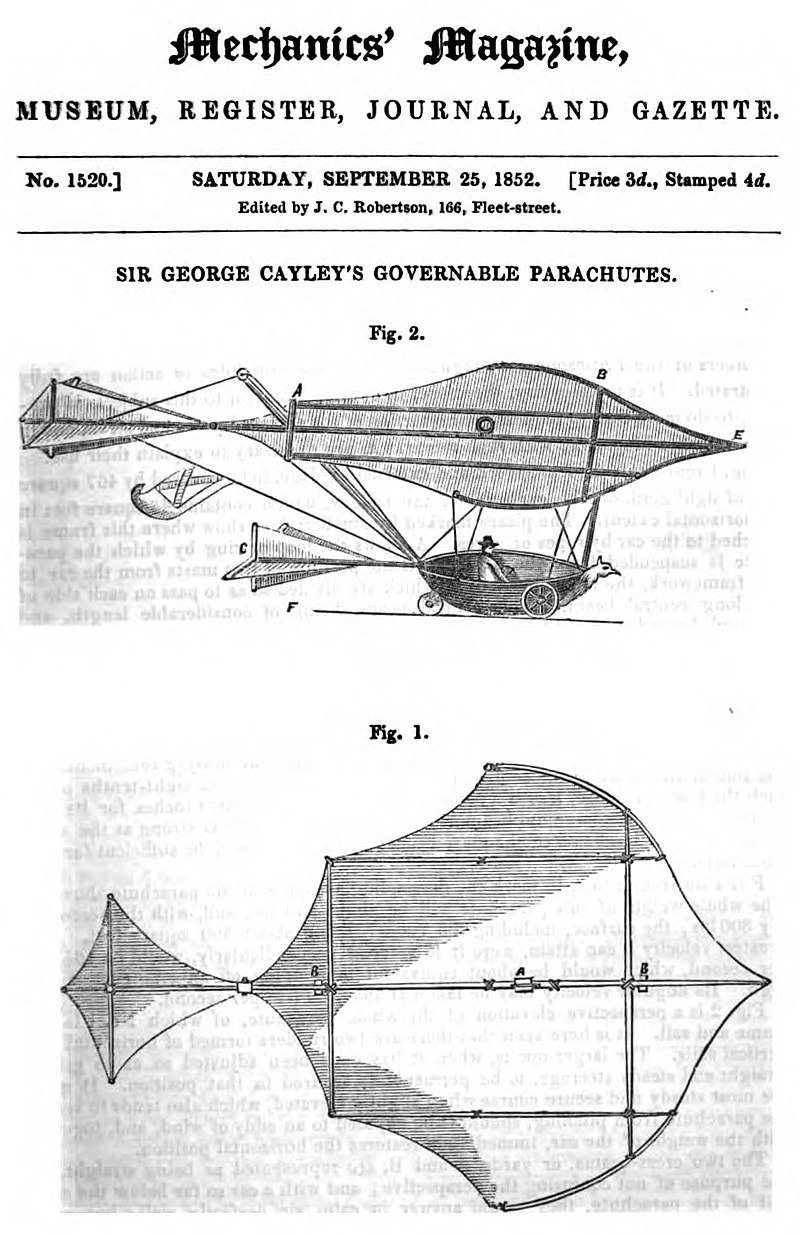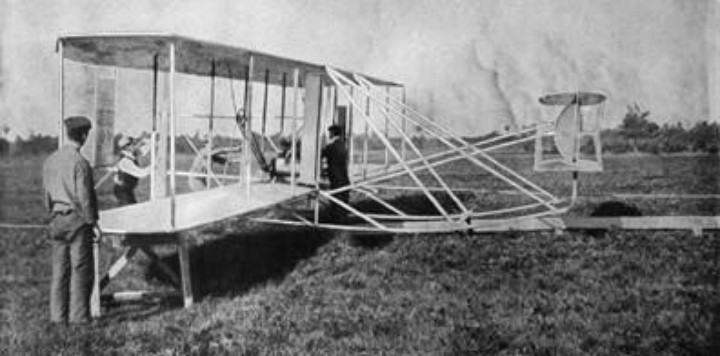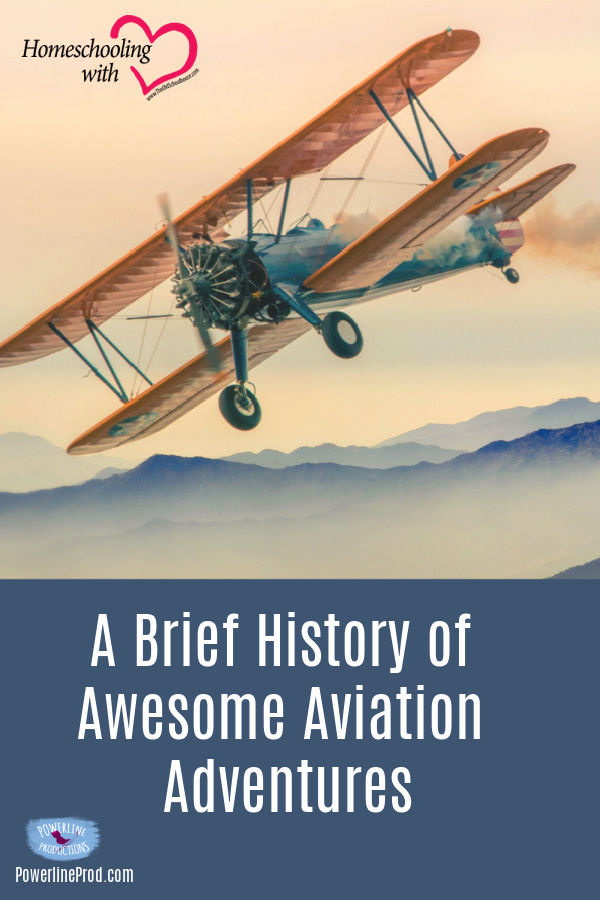A Brief History of Awesome Aviation Adventures


I’m heading up to Atlanta next week. I’ll hop on a plane with my husband, and an hour later, we’ll be at our destination.
Each time I fly, I’m overwhelmed by the miracle of flight—that we can soar through the air on a huge heavy plane!
Aviation history is thrilling. I want to dive into every detail! Instead, I’ll just touch on some of the highlights from early flight adventures. I’m hoping this will inspire your family to explore more!
Chinese Kites
A thousand years before Jesus was born, the Chinese people invented kites. They flew on their kites to spy on enemy troops.
Monk Oliver Breaks His Legs
A thousand years after Jesus’ birth, Benedictine Monk Oliver jumped from his abbey with the aid of wings. After a very brief flight, he fell and broke his legs.
Marco Polo Observes Humans Flying on Kites
When Marco Polo visited China, he was amazed to see huge kites carrying people!
Leonardo Designs Flying Machines
Leonardo da Vinci drew a flying machine after studying bird wings.
Hezarfen Celebi Leaps & Lands
In Turkey, Hezarfen Celebi jumped from a tower and flew, landing in the marketplace of Scutari.
Model Hot Air Balloon
In Portugal, Father Bartolomeu de Gusmao created a model of a hot air balloon. Then, he demonstrated how it worked to King John V in 1709.
First Hot Air Balloon Rides
The Montgolfier brothers, Joseph and Jacques, created a hot air balloon in 1783. They had 3 successful flights: with human passengers, with animal passengers, and unmanned. The balloon was powered by burning wood.
The next year, the Montgolfier brothers flew in their hot air balloon with 6 passengers. Hot air balloons became popular!
Andre Parachutes out of a Balloon
In 1787, Andre Jacques Garnerin leaped from a hot air balloon 2,000 feet in the air. Lucky for him, he was wearing a newly-invented parachute.
Sir George Cayley Builds a Glider
In 1799, Sir George Caylay of England created a design of a fixed-wing aircraft. Five years later, he built the first successful model glider.
In 1852, Sir George and his grandson George John Cayley completed a large glider that flew an adult.

Sir George Cayley was one of the first people to understand and identify weight, lift, drag, and thrust. He is considered the Father of Aviation.
Clement Flies a Steam-Powered Monoplane
In 1890, Clement Ader flew a steam-powered 1-wing plane a distance of 160 feet outside of Paris.
Otto Lilienthal
Otto Lilienthal enjoyed several glider flights in the summer of 1891. These flights were observed to be safe and repeatable. People began to see gliding in a different light.
Over the next few years, he improved his designs. Unfortunately, he died in 1896 in a glider accident.
Zeppelin Airships
In 1900, the airship Zeppelin took her first flight.
Wright Brothers
In 1892, the Orville and Wilbur Wright opened a bicycle shop. However, their hearts were on flight. In 1900, the brothers took their first glider flight. In 1902, they modified their glider to make it more flyable.
On December 17, 1903, the Wright brothers had the first successful powered, manned, heavier-than-air flight. It lasted only 12 seconds.

Over the next few years, they modified their plane, improved their flying, and eventually started a business selling airplanes and training pilots. They sold their flights to Americans, British, French, Italian, and German buyers and the U.S. War Department.
Flying airplanes traveled around the world with folks crossing the English Channel (Louis Bieriot), gaining speed (Glenn H. Curtiss won speed tests), flying across North America (Cal Rodgers from NY to CA), and first night flight (Charles W. Hamilton).
First Helicopter
French inventor Paul Cornu flew the first helicopter in 1907. In 1939, Igor Sikorsky piloted a helicopter lifting off the ground 3 feet for 10 seconds. Later on, in the Vietnam War, helicopters would be the “work horse” of the U.S. Army.
World War I
The brand-new airplanes were used in World War I for reconnaissance.
At first, enemy pilots just waved to each other. Soon, however, they began to shoot at each other and throw grenades out of the planes on the enemy below. Dog fights became part of fighting in the air.
What is a dog fight?
A dog fight is a battle in the air conducted at close range. The fights often took the form of a dance between the pilots in the air with swooping and swirling and turning and dodging. Pilots learned to fly their planes in all different directions to avoid a hit.
Speaking of World War I, learn more about World War I heroes on this podcast: 7 Amazing World War I Heroes
Boeing Is Born
In 1916, Boeing was founded by William Edward Boeing, an aviation pioneer. The company designed, manufactured, and sold airplanes. Later on, they would design, manufacture, and sell missiles, rockets, and satellites.
USS Langley
The USS Langley was the first American aircraft carrier, commissioned in 1926.
Charles Lindbergh
Charles Lindbergh flew across the Atlantic Ocean by himself in 1927 on the Spirit of St. Louis from New York to Paris.
Amelia Earhart
Amelia Earhart was the first woman to cross the Atlantic Ocean.
Toy Airplanes
Model Airplanes became popular in the 1930s as little boys dreamed of growing up to be pilots. At the end of the century, remote control planes became popular with kids and even more popular with dads.
Airship Crashes in New Jersey
German airships (Zeppelins) were a popular form of transportation until one crashed in New Jersey in 1937 and burst into flames.
Commercial Airlines
Just like the Wright brothers started a business selling planes and giving pilot lessons, other folks started businesses flying passengers in planes. The first commercial airline companies were founded in 1920: KLM ( Netherlands) and Qauntas (Australia). Finnair (Finland) was founded in 1923.
Early European airlines were spacious and comfortable. Passenger cabins were luxurious. In America, Pan Am and Northwest Airways were the only airlines with international flights in the 1930s.
World War II
In 1941, U.S. fighter pilots flew across the Pacific together, the Tuskagee Airmen (first black fighter squadron) was formed, and there was a surprise fighter pilot attack on the naval base in Pearl Harbor, Hawaii. The USA enters World War II immediately. Airplanes played a huge role in the battles of World War II, ending in an Allied victory!
Speaking of the Attack on Pearl Harbor, learn more by listening to this podcast: Pearl Harbor 12.7.41.
Golden Age of Flying
Jet airliners were introduced in the 1950s and good-bye to noisy propellers. Though plane tickets were expensive, you would be treated like royalty once you were on the airplane with unlimited food, drinks, and snacks. Magazines, newspapers, pillows, and blankets were provided to passengers. To get on your airplane, you had to walk across the tarmac and climb up stairs.
The flight crew (pilots and flight attendants) operated the airplane and took care of the passengers. Planes had three pilots: the captain, the first officer, and a navigator. The ground crew took care of everything at the airport with flight dispatchers, baggage handlers, ramp agents, aerospace engineers, gate agents, ticket agents, reservation agents, and crew schedulers.
What Happens Next
From jumbo jets to rockets with the Concorde flying faster than the speed of sound, flight has continued to advance throughout the 20th Century and on to the 21st.
This brief history of aviation is a great jumping off point for a unit study on pilots, aviation pioneers, airline companies, aviation manufacturers, or airports. Have fun learning more about this fascinating field of study!
Until next time, Happy Homeschooling,
Warmly,
Meredith Curtis
Meredith Curtis, homeschooling mom, writer, speaker, and publisher, loves to encourage families in their homeschooling adventure. She is the author of HIS Story of the 20th Century series, Celebrate Christian in Germany Unit Study, Celebrate Christmas in Colonial America Unit Study, and Celebrate Christmas with Cookies Unit Study. You can check out her books, curricula, unit studies, and Bible studies at PowerlineProd.com. Read her blogs at PowerlineProd.com and listen to her at Finish Well Radio.














































